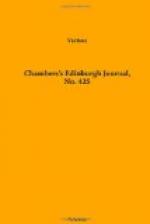We went at an early hour one day to see the Pisani palace: one of those which are attractive on account of their containing good works of art. The Pisani are an illustrious family: and the representative still lives in this fine old mansion, or at least occasionally occupies it; but he is a broken-down old man, who has survived wife, children, and other relatives, and his death must speedily close the many-centuried history of his name. It was with melancholy feelings that we stepped into the hall or vestibule, whose broken plasters are still graced with coats-armorial and emblems of ancient dignity; amongst the rest, two standards wrapped up round their staves, probably memorials of the great Pisano—a naval commander of the fourteenth century. The housekeeper’s little children were playing about the place, as children in an ordinary city would play in a street among the dogs and carriages. Mounting a wide side-staircase, we reached a handsome first floor, composed of a central salle and side-rooms, tolerably furnished; and here we found the two pictures for which the Pisani are famous—The Death of Darius, and his Queen supplicating Alexander, by Paul Veronese. They are beautiful paintings; and by their value, still give a sort of dignity to this decayed family.
Another palace we visited was that of the Vendramini Colerghi, now the property of the Duchesse de Berri, who makes it her ordinary winter-quarters. It is a large and elegant building, in a form approaching that of the letter Z, with a flower-garden in front of the receding part. The duchesse is understood to have purchased it for 120,000 zwanzigers—equivalent to about L.4000, and not the value of the stones of which it is built. With great good taste, she has made no alteration in the decoration or destination of the rooms, but has added modern furniture, family portraits, and many objects of virtu. The series of apartments on the first floor above the vestibule is extensive and superb; and though the tout ensemble is more characteristic of a modern French princess than of an ancient Venetian family, it was pleasant to see at least one of the palazzos of the ancient republic handsomely furnished, and having the appearance of cheerful occupation. Among the portraits are some that could scarcely have been expected to survive the Revolution of 1792—as Louis XIV.; Louis XV. when a boy; some of the princesses, aunts of Louis XVI.; also the dauphin, father of the latter monarch. There is likewise a beautiful cabinet of Marie Antoinette. Such articles, we presume, must have been obtained from the palaces at the downfall of royalty, and preserved by various accidents till the restoration, when the royal family would of course be eager to recover them at whatever expense. We saw here a portrait of the Duchesse, with her infant son, standing in widow’s weeds, beside the bust of her assassinated husband; also portraits of the Due de Bourdeaux, his wife, the Duchesse’s present husband, and her younger set of children. In a glass-case were the gilt spurs of Henri IV. The Duchesse gives gay parties in winter, when the full suite of rooms must have a fine effect.




